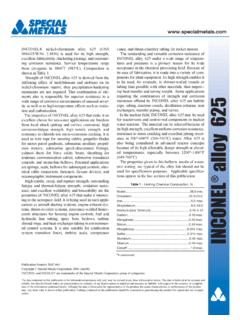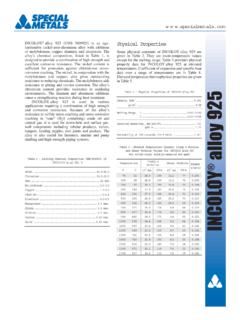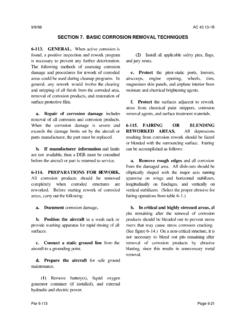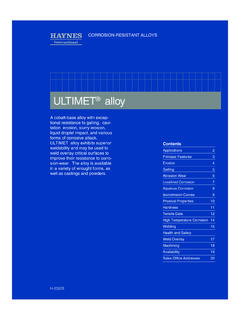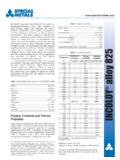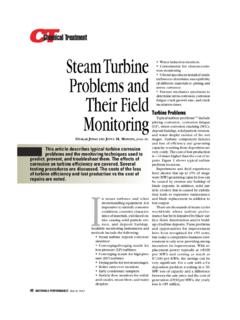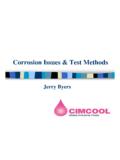Transcription of www.specialmetals
1 INCONEL alloy 690 (UNS N06690/W. Nr. ) is Table 1 - Limiting Chemical Composition, %, a high-chromium nickel alloy having excellent of INCONEL alloy 690a resistance to many corrosive aqueous media and high- temperature atmospheres. In addition to its corrosion Nickel .. min. resistance, alloy 690 has high strength, good Chromium .. metallurgical stability, and favorable fabrication Iron .. characteristics. Carbon .. max. The chemical composition of INCONEL alloy 690 Silicon.. max. is listed in Table 1. The substantial chromium content Manganese .. max. gives the alloy outstanding resistance to oxidizing Sulfur .. max. chemicals and to high-temperature oxidizing gases. Copper .. max. The high level of nickel imparts resistance to stress- INCONEL alloy 690. corrosion cracking in chloride-containing environments a Amendments for nuclear applications: 28-31 Cr, max.
2 C, as well as to sodium hydroxide solutions. max. Co. The properties of INCONEL alloy 690 are useful for various applications involving nitric or nitric/hydrofluoric acid solutions. Examples are tail-gas Physical Constants and Thermal reheaters used in nitric acid production and heating coils and tanks for nitric/hydrofluoric solutions used in Properties pickling of stainless steels and reprocessing of nuclear Table 2 gives melting range and some physical fuels. constants at room temperature for INCONEL alloy 690. The alloy's resistance to sulfur-containing gases Table 3 contains values for thermal and electrical makes it an attractive material for such applications as properties over a range of temperatures. Values for coal-gasification units, burners and ducts for processing specific heat were calculated; other values were sulfuric acid, furnaces for petrochemical processing, measured.
3 Modulus of elasticity in tension, determined recuperators, incinerators, and glass vitrification by a dynamic method, is shown for temperatures to equipment for radioactive waste disposal. 1600 F (870 C) in Table 4. All measurements of In various types of high-temperature water, alloy physical properties were done on annealed specimens. 690 displays low corrosion rates and excellent resistance to stress-corrosion cracking. Thus, alloy 690.. is widely used for steam generator tubes, baffles, tubesheets, and hardware in nuclear power generation. Table 2 - Physical Constants Density, .. Mg/m3 .. Melting Range, F ..2450-2510. C ..1343-1377. Specific Heat, Btu/lb- F .. J/kg- C ..450. Electrical Resistivity, ohm-circ mil/ft ..691. -m .. Permeability at 200 oersteds ( kA/m) .. Young's Modulus, 103 ksi .. GPa ..211. Poisson's Ratio .. Publication Number SMC-079. Copyright Special Metals Corporation, 2004 (Sept 04).
4 INCONEL, INCOLOY, and MONEL are trademarks of the Special Metals Corporation group of companies. The data contained in this publication is for informational purposes only and may be revised at any time without prior notice. The data is believed to be accurate and reliable, but Special Metals makes no representation or warranty of any kind (express or implied) and assumes no liability with respect to the accuracy or completeness of the information contained herein. Although the data is believed to be representative of the product, the actual characteristics or performance of the product may vary from what is shown in this publication. Nothing contained in this publication should be construed as guaranteeing the product for a particular use or application. INCONEL alloy 690. Table 4 - Modulus Data (Annealed). Table 3 - Thermal and Electrical Properties Coefficient of Temperature, Young's Modulus, Shear Modulus Poisson's Thermal Specific Electrical Temperature F C 103 ksi MPa 103 ksi MPa Ratio Conductivity Expansiona Heat Resistivity F F 10-6 F Btu/lb- F ohm-circ mil/ft 70 21 75 - - 691 200 93 200 93 698 400 204 400 107 710 600 316 600 122 723 800 427 800 136 736 1000 538 1000 151 745 1200 619 1200 165 745 1400 760 1400 179 749 1600 871 1600 194 753 1800 982 1800 207 760 2000 1093 *.
5 2000 - 768 * Extrapolated value. C W/m- C m/m/ C J/kg- C -m 25 - - 450 100 471 200 497 300 525 400 551 500 578 600 604 700 631 800 658 900 684 1000 711 1100 - 738 a Between 75 F (24 C) and temperature shown. b Extrapolated values. Mechanical Properties INCONEL alloy 690 has high strength over a broad range of temperatures. Mechanical properties of the alloy vary with product form and temper. Alloy 690 is normally used in the annealed temper, and strength characteristics described below are representative of annealed material. The usual annealing temperature is approximately 1900 F (1040 C). The effect of different annealing temperatures on the tensile properties of cold-worked material is shown under Fabrication in Figure 8. Tensile Properties Fatigue Strength At room and elevated temperatures, INCONEL alloy 690 The results of low-cycle fatigue tests performed at room displays high yield and ultimate strengths along with good temperature are shown in Figure 2.
6 The specimens were ductility. Table 5 lists results of room-temperature tensile tested under axial strain with fully reversed loading. tests on annealed material. As indicated by the values, tensile properties may vary with product form and size. At high temperatures, alloy 690 retains a substantial level of tensile properties with temperatures of over 1000 F (540 C). required to produce significant declines in strength. Figure 1 shows the results of short-time tensile tests performed at temperatures to 1800 F (982 C). The curves represent average values for both cold-worked and hot-worked products in the annealed temper. 2. INCONEL alloy 690. Table 5 - Room-Temperature Tensile Properties of Annealeda INCONEL alloy 690. Size Yield Strength ( Offset) Tensile Strength Elongation Form in. mm ksi MPa ksi MPa %. b Tube , cold drawn x x 461 758 39. x x 379 700 46. x x 282 648 52.
7 Flat, hot rolled x 13 x 51 352 703 46. Rod, hot rolled dia. 51 dia. 334 690 50. Rod, hot rolled dia. 16 dia. 372 738 44. Strip, cold rolled thick 348 724 41. a 1900 F (1040 C). b Dimensions are outside diameter and wall thickness. Temperature, C 10. 0 100 200 300 400 500 600 700 800 900 1000. Total Strain Range, %. 120 800. INCONEL alloy 690 (Solution Annealed). Elongation, %. 100 700. Tensile Strength 600. 80. Stress, MPa 500. 60 400. Elongation 300 Stress, ksi 40 102 103 104 105 106. 200. Tensile Strength Cycles to Failure 20 ( Offset) 100. Figure 2. Low-cycle fatigue strength at room temperature of 0 0 annealed INCONEL alloy 690. 0 200 400 600 800 1000 1200 1400 1600 1800 2000. Temperature, F. Figure 1. High-temperature tensile properties of annealed INCONEL alloy 690. Data are a composite of cold worked and hot worked product. Creep and Rupture Properties Stability of Properties INCONEL alloy 690 offers attractive properties for Alloy 690 has a high degree of metallurgical stability, applications involving extended service at elevated forming no embrittling phases during long-time exposure to temperatures.
8 The alloy has good creep-rupture strength elevated temperatures. As shown in Table 6, room- along with metallurgical stability and resistance to high- temperature tensile properties and impact strength are not temperature corrosion. significantly changed by exposure to critical intermediate Time-dependent strength levels for INCONEL alloy temperatures for 12,000 h and longer. The samples were in 690 are indicated by Figures 3 and 4, which respectively the annealed condition prior to exposure. show creep rate and rupture life as functions of stress and temperature. The tests were performed on material annealed at 1900 F (1040 C). 3. INCONEL alloy 690. 100 700. 80 C). 900 F (4. C). F (540. 1000 . C). F (595. 1100 100. C) C). 10. F (650 F (760. 1200 1400 . C). F (705. 1300 C). (870. Stress, MPa Stress, ksi 0 F. 160. 10. 1. 80 C). 1800 F (9 C). (1095. 0 F. 200. 1.
9 1. Creep Rate, %/h Figure 3. Creep strength of annealed INCONEL alloy 690. 100 700. 900 F (480 C). 1000 F (5. 40 C). 1100 F. (595 C). 1200. F (6 100. 50 C. ). 10 1300. 1400 F (7. F (7 05 C. 60 C ). ). Stress, MPa Stress, ksi 1800. F (9 160. 80 C 0 F. ) (87. 0 C. ). 200 10. 0 F. (109. 1 5 C. ). 1. 1 10 100 1000 10 000 100 000. Rupture Life, h Figure 4. Rupture strength of annealed INCONEL alloy 690. 4. INCONEL alloy 690. Table 6 - Effect of High-Temperature Exposure on Room-Temperature Properties of INCONEL alloy 690. Exposure Temperature Exposure Yield Strength ( Offset) Tensile Strength Elongation, Impact Strength F C Time, h ksi MPa ksi MPa % ft-lb J. No exposure - 283 714 48 140 190. 1050 565 1 000 334 727 45 115 156. 4 000 324 724 45 126 171. 12 000 314 727 44 121 164. 1100 595 1 000 431 738 45 144 195. 4 000 321 731 43 125 170. 13 428 314 727 44 125 170. 1200 650 1 000 323 727 46 146 198.
10 4 000 334 731 54 132 179. 12 000 318 748 41 127 172. 1400 760 1 000 345 738 44 158 214. 4 000 306 714 44 148 201. 12 000 321 714 46 136 184. Corrosion Resistance INCONEL alloy 690 has excellent resistance to corrosion in a broad range of aqueous and high temperature environments. Because of its high chromium content, the alloy is particularly resistant to oxidizing conditions. Alloy 690 also offers excellent resistance to attack by sulfur at high temperatures. Corrosion by Acids 140. Boiling point of - 280. nitric acid Alloy 690 has good resistance to many oxidizing acid 120. 5-10 mpy - 230. solutions. It is especially useful for handling nitric and 100. ( mm/a). nitric/hydrofluoric acids. In nitric acid, laboratory tests have Temperature, C. Temperature, F. shown the alloy to corrode at rates less than 1 mpy ( 80 - 180. 0-5 mpy ( mm/a). mm/a) in concentrations through 70% at room temperature 60.
